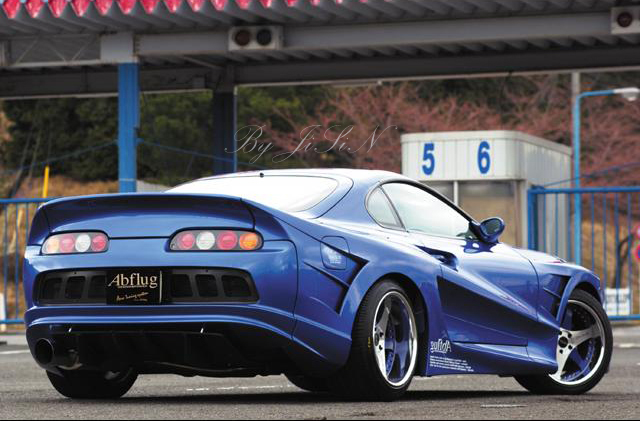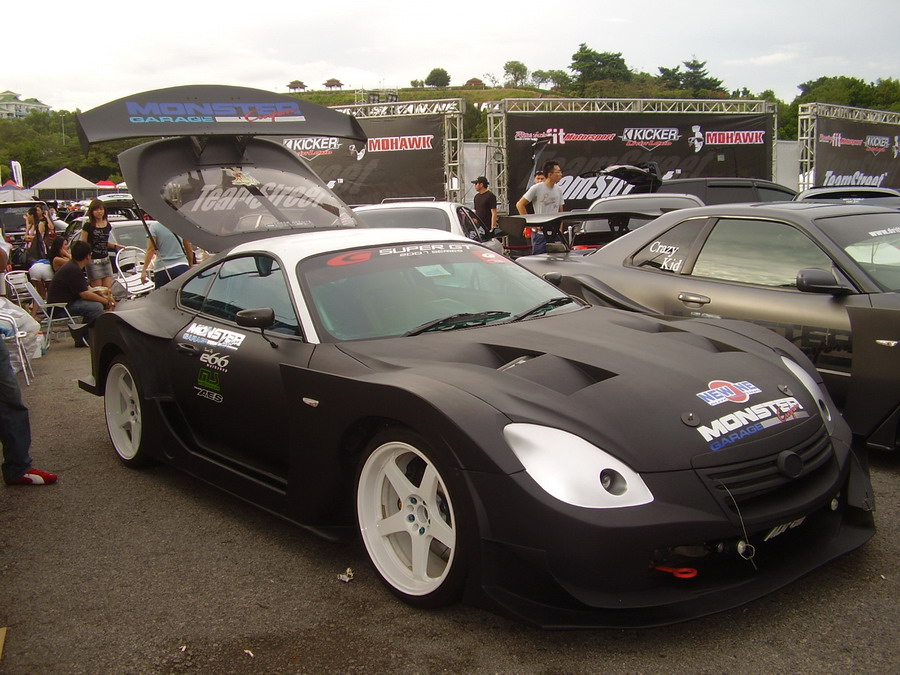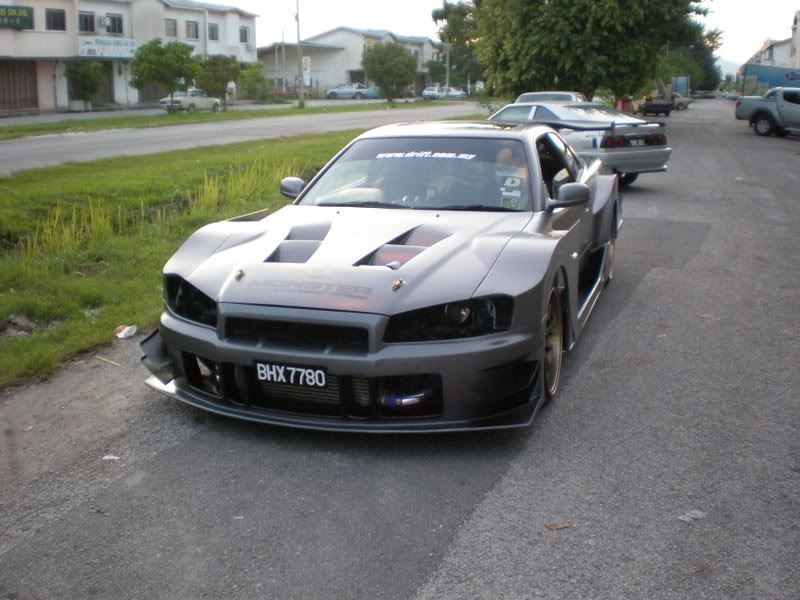|
|

楼主 |
发表于 3-10-2012 02:10 PM
|
显示全部楼层
Looking Inside a NGTC
Today’s blog will take a quick look at a NGTC from a touring car drivers perspective!
So what does the inside of a NGTC touring car look like and what technology can we see?
Lets take a look…

As with all race car’s where weight saving is a priority the interior has been entirely stripped out leaving just the bare minimum.
1, All electronic controls and information required by the driver is positioned around the steering column. This is a trait of all recent team dynamics cars including the last Civic, the Integra and 2001 Civic.
It is slightly unusual as the weight of all the cabling and switch gear is surprisingly heavy maybe 2-3kg. A lot of teams choose to mount theses switches much lower to the left of the driver mounted off the floor, to help lower the center of gravity of the car.
These switch will include buttons for controlling a screen blower, wipers, alarm reset etc..
2, Shows the shifter lights, these will illuminate to help show the driver the optimum time to change gear.
3, The electonic dash screen will show rev counter, engine temp, oil pressure, oil temp etc.
4, Buttons on the steering wheel will control often used controls such as car to pit radio controls, main lights, the steering wheel is removable with a quick release coupling to aid the driver getting into and out of the cars.
5, The front right air jack is clearly visible, This exhausts into the car when realeased resulting in the loud roar of compressed air into the car cabin.
6, This item is a hydraulic line lock, (brake bias is controlled via the pedal box) this lock is used as a kind of hand brake and can keep brake pressure to the rear calipers to prevent the car from rolling. Comment from a reader shown below, informs me, that this item is an additional brake bias control, which is in addition to the pedal box bias. A “handbrake” function is controlled by an electronic solenoid valve which holds the pressure to the rear calipers and is released by pushing a button on the steering wheel.
7, Part of the reason that BTCC racing is so close is the use of success ballast which is awarded to the most successful drivers to equal the field. This shows the ballast box which all BTCC touring cars must be equipped with and is where the cars ballast must be fitted. The ballast it usually flat lead plates and it has to be securely bolted to the cars body.
8, This shows the sequential gear box gear lever, Rather than a “H” pattern gear box found in a standard civic all NGTC will use the Xtrac 6 speed sequencial box, where the gears are slected sequencially by pulling on the lever to progress up through the gear box and push to move down through the gears. The arrow is pointing at the sensor on the gear lever this sensor senses the lever being pushed and kills the ignition for a fractio of a second to help the gear change process.
8, Gear selector lever connection rod. This rod connected one end to the gear lever passes forward through the bulk head and into the engine bay where it connects to the Xtrac gearbox. This connection rod converts the pull or push onto the gear lever into a gear change.
9, Here you can see the cars ECU mounted as close to the floor as possible, so to keep the cars center of gravity as low as possible.
10, Just in view is the cast aluminium AP racing pedal box, This pedal box contains the front brakes master cylinder, the rear brake master cylinder, the clutch master cylinder and throttle pedal which will be connected to the electric fly by wire throttle system.
The pedal box also contains the brake bias system which allows the driver to alter the brake bias from front to rear.
|
|
|
|
|
|
|
|
|
|
|
|

楼主 |
发表于 3-10-2012 02:11 PM
|
显示全部楼层
A quick look at the rear of a NGTC BTCC Civic
Today we have our first look at the rear of a BTCC NGTC Civic.
So what work has had to be done to Dynamics Civic to fit the standard NGTC subframe?
Photo courtsey of @MattNealRacing on Twitter.

1, Following on from my previous posts where I highlighted the amount of material which had been removed from the standard shell. Here you can see that team Dynamics have replaced the inner arch with a bespoke steel fabrication which fits neatly around the standard NGTC rear subframe and double wishbones. The join between standard Civic shell and bespoke fabrication is shown by the straight dotted lines (labeled number 5).
Team Dynamics have managed to package around the rear suspension with a very neat solution.
2, Here you can see the standard NGTC Double wishbone which replaces the standard civics trailing beam.
3, This curved line I have added to the photo shows the line the standard wheel arch would normally follow, and illustrates how much Dynamics have inlarged the arch to allow the car to be lowered and fit the NGTC wheels. It is clear to see that even the rear door has been modified to accommodate this. This of course will all be tided up when Team Dynamics add the rear fiber class arches.
4, Moving away from the five stud wheel pattern of the S2000 specification touring cars, The NGTC specification cars The single center lock Nut can be seen here, This is part of the new regulations and may have been included by Toca to try to speed up pit stops.
However as the BTCC races are only 2o minutes long and pit stops are only used in the case of punctures or sudden weather changes it may do nothing other than increase the number of wheel which the fans see come loose, as we used to see in the older BTC specification cars!
In my next blog we will take a look at the difference between double wish bone suspension and McPherson strut suspension…..
|
|
|
|
|
|
|
|
|
|
|
|

楼主 |
发表于 3-10-2012 02:12 PM
|
显示全部楼层
The Engineering behind a roll cage installation.
in my last post we looked at the Engineering which “Team Dynamics” have but into preparing there shell by examining the Photos which Team Dynamics had published on Twitter. In this Post we will we look at the enginering behind installing a roll cage, again we will be examing a Team Dynamics photo. The photo was kindly published by Mat Neal Via his Twitter account (@ MattNealRacing)In Touring cars a roll cage has two main functions the first and most obvious function is to protect the driver in the case of a crash or a roll, the second slightly less obvious function is to stiffen the shell and to to tie the suspention points together.
It is surprising how much deflection and twist a standard uncaged production car has. A race car with a flexing shell would be difficult to predict and setup for the race track and as a result would be slow.
The balancing act when designing a roll cage is the trade off between safety, stiffness and weight. Obviously a cage has to be strong enough to protect the driver in the event of a crash, has to be Stiff enough to not allow body flex but also as light as possible so as to allow the car to be competitive.
With the NGTC rules meaning that all entrants suspension will be identical the shell that sits between the specification and ties it together will be more important than ever and could easily make the difference between a good car and a poor car.

Although Team Dynamics can demonstrate considerable skills and prowess in Motorsport engineering I believe it is likely that they will have out sourced the cage design to a specialist company such as “Custom cages” or “Safety Devices” for the cage design to ensure that the best solution is utilised.
There are two main materials which cages tend to be constructed from “T45″ High tensile carbon manganese steel and “CDS” Cold Drawn Seemless Carbon steel.
T45 is stronger than CDS meaning that a thinner tube wall thickness can be used to acheive the same strength cage as CDS and as a result a lighter roll cage can be made. T45 However is significantly more expensice than CDS.
Team Dynamics will definitely be using a T45 roll cage.
What else can we see from dynamics photo? I have highlighted the following points on the photo:
1, The impressive triangulation of the cage can clearly be seen. Also the diagonal bracing of the car from left to rear can be seen to be positioned quite far toward the rear of the car. Its positioned to the rear of the “B” pillar of the shell, this will allow the driving position to be much further back that in a standard road car. The drivers shoulder will probably line up with or be slightly behind the cars “B” pillar.
2, The cut out sections highlighted in the last post have been replaced with bespoke sheet metal fabrications increasing the space available for the rear suspension and rear wheels. The amount of shell which has been cut away is also evident in this photo as the cut away encroaches into the door shut area.
3, The full tank can be seen to be located in almost in the centre of the car. In past generation touring cars the Tank has been located further towards the rear of the car. This was to try to help balance the inherent front heaviness of a front engine, front wheel drive car. However it was found in the past that the handling of the car was adversely effected as the tank emptied during the race. Locating the tank in the center of the car helps the cars handling be predictable on both full and empty tanks.
4, The location of the fire extinguisher can be revealed to be positioned next to the fuel tank this moves away from some teams tradition of installing fire extinguishers in the passengers foot well. Installing the fire extinguisher in the center of the car will slightly increase the length of hosing needed but will help with the cars COFG. The rules mandate at least one nozzle directed into the engine bay, one at the driver and one at the fuel tank.
5, Team Dynamics impressive attention to detail is demonstrated here, where you can see the exact spacing of welds around the door shut has been measured and marked out for the fabricators to follow, creating a very neat uniform stiching of weld.
6, The rear cage points can be seen to continuing to the rear floor of the shell rather than to the traditional rear damper mounts on top of the rear wheel arch inner. This is notably different to the S2000 specification cars which used macpherson struts suspention, this is due to the civic now utilizing the NGTC double wishbone rear suspension, the cage will tie into the spec NGTC subframe at this point.
The next part of the Team Dynamics NGTC build will be to paint and assemble the shell.
|
|
|
|
|
|
|
|
|
|
|
|

楼主 |
发表于 3-10-2012 02:13 PM
|
显示全部楼层
What do Team Dynamic’s (Honda’s BTCC Racing team) photo’s show us?
The excellent thing about Motorsport today is the access that fans can now get to the “behind the scenes” Engineering that goes into building a race car.
This is demonstrated by the Photos which have been published by Team Dynamics via Twitter of their new car build.
After a successful 5 years of campaigning the “FN2″ Honda Civic Type R Team dynamics are now building four 2012 model year Civics to the new BTCC Next generation Touring car regulations (NGTC), to be campaigned in the 2012 touring car season.
The NGTC regulations tightly defined specifications where control double wishbone suspension front and rear suspension has to be used by all vehicles regardless of there original layout
So what can we see in these photos? Lets take a look:

This photo has been during the shell preparation stage before the roll cage has been installed. Usually a team will start with a complete car and strip it down to the bare shell to commence a new build, However it is likely that as team dynamics are sponsored by Honda that they were supplied with bare “body in white” (BIW’s) straight from the Honda factory in Swindon where the Civic is built.
The photos indicates as expected team dynamics will be using the right hand drive variant of the civic.
The lack of sealant and noise reduction mastic on the seams of the shell indicates that dynamics have acid dipped the shells, this can save a few kilo’s. Weight saving with attention to detail like this can make a difference between a competitive car and a mediocre car.
Other things of note which I have highlighted in this photo are:
1, The surprising amount of the rear shell which has been cut away, The entire rear floor section including both left and right inner wheel arches have been drastically cut away this to make way for the new TOCA specification rear double wishbone suspension.
2, The front floor area has also been cut away, this is where the fuel tank on a road going civic is normally located (Which of course is not used in touring cars) this has probably been done to allow the drivers seat to be positioned lower, to help lower the center of gravity of the car.
3, The second hole on the passengers side has probably again been made to lower the floor and allow ancillary equipment such as the battery electrical equipment to sit as low as possible.
4, At first glance the position of this hole looks to be for the Left hand front air Jack but on closer inspection it looks to be positioned too far to the rear. for that, Its possibly to house the Engine Oil accumulator that dynamics use to guarantee oil pressure to the engine.
5, The additional seem welded Team Dynamics have carried out to the shell can be clearly seen. this is in addition to the standard spot welds which Honda use to construct the shell and is done to stiffen the shell as much as possible to reduce body flex.
Also we can see in this photo that the roof skin and the roof stiffeners have been removed, this will be to aid access for the cage installation and the roof panel will be re installed once the cage is complete.
One single photo can show a lot about the amount of engineering that goes into building a lattest generation touring car. The next step for team dynamics will be the roll cage installation….and Ill be back with my next post to see what photos of the roll cage can show us about Team Dynamics Engineering..
|
|
|
|
|
|
|
|
|
|
|
|

楼主 |
发表于 3-10-2012 02:14 PM
|
显示全部楼层
|
|
|
|
|
|
|
|
|
|
|
 发表于 3-10-2012 02:18 PM
|
显示全部楼层
发表于 3-10-2012 02:18 PM
|
显示全部楼层
你问我的话,这不叫爆改了...
这叫厂车... 下track的...
不是我们这些改爽的... |
|
|
|
|
|
|
|
|
|
|
|
 发表于 3-10-2012 02:20 PM
|
显示全部楼层
发表于 3-10-2012 02:20 PM
|
显示全部楼层
我心目中的爆改....
像当年00+的时候红透半边天的supra...
 |
|
|
|
|
|
|
|
|
|
|
|
 发表于 3-10-2012 02:24 PM
|
显示全部楼层
发表于 3-10-2012 02:24 PM
|
显示全部楼层
Malaysia Monster Garage的手笔.... 我记得是supra改来的...

Monster Garage R34

|
|
|
|
|
|
|
|
|
|
|
|

楼主 |
发表于 3-10-2012 02:27 PM
|
显示全部楼层
hayuku86 发表于 3-10-2012 01:18 PM 
你问我的话,这不叫爆改了...
这叫厂车... 下track的...
不是我们这些改爽的...
不懂改到这样能在街上走吗。。。??
|
|
|
|
|
|
|
|
|
|
|
|
 发表于 3-10-2012 02:33 PM
|
显示全部楼层
发表于 3-10-2012 02:33 PM
|
显示全部楼层
|
|
|
|
|
|
|
|
|
|
|
 发表于 3-10-2012 03:50 PM
|
显示全部楼层
发表于 3-10-2012 03:50 PM
|
显示全部楼层
|
|
|
|
|
|
|
|
|
|
|
 发表于 3-10-2012 03:52 PM
|
显示全部楼层
发表于 3-10-2012 03:52 PM
|
显示全部楼层
很专业,很多技术都是不会在一般的车所看见的。。。赞!!
|
|
|
|
|
|
|
|
|
|
|
|
 发表于 3-10-2012 05:52 PM
|
显示全部楼层
发表于 3-10-2012 05:52 PM
|
显示全部楼层
|
|
|
|
|
|
|
|
|
|
|
 发表于 3-10-2012 06:34 PM
|
显示全部楼层
发表于 3-10-2012 06:34 PM
|
显示全部楼层
|
|
|
|
|
|
|
|
|
|
|
 发表于 3-10-2012 07:51 PM
|
显示全部楼层
发表于 3-10-2012 07:51 PM
|
显示全部楼层
改到酱。。。
要驾车去买包烟都很难
 |
|
|
|
|
|
|
|
|
|
|
|
 发表于 3-10-2012 10:06 PM
|
显示全部楼层
发表于 3-10-2012 10:06 PM
|
显示全部楼层
|
|
|
|
|
|
|
|
|
|
|
 发表于 4-10-2012 12:54 AM
|
显示全部楼层
发表于 4-10-2012 12:54 AM
|
显示全部楼层
|
|
|
|
|
|
|
|
|
|
|
 发表于 12-10-2012 01:46 PM
|
显示全部楼层
发表于 12-10-2012 01:46 PM
|
显示全部楼层
我好喜欢啊~.gif) |
|
|
|
|
|
|
|
|
|
| |
 本周最热论坛帖子 本周最热论坛帖子
|